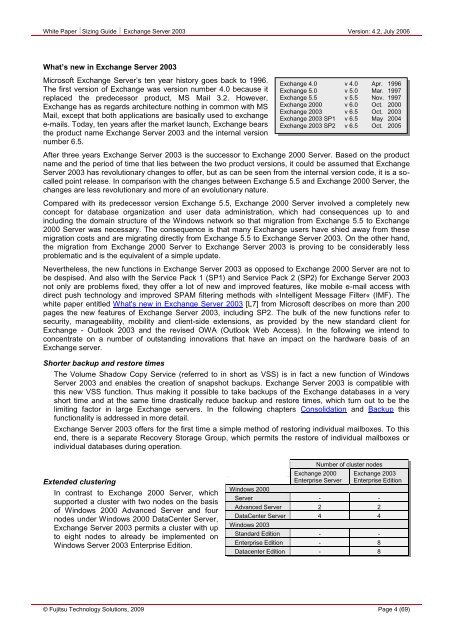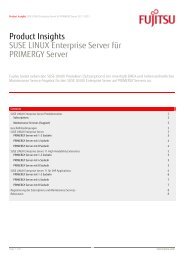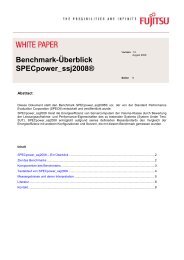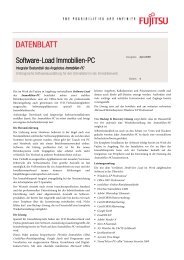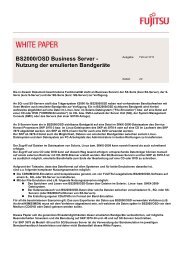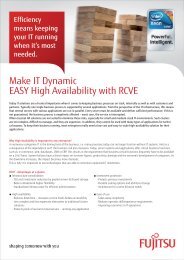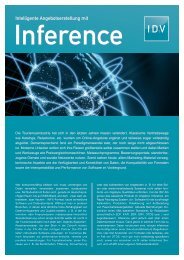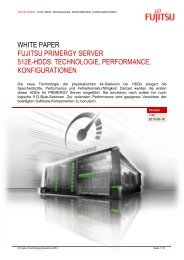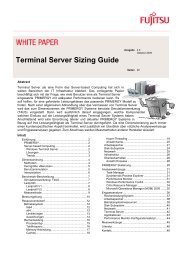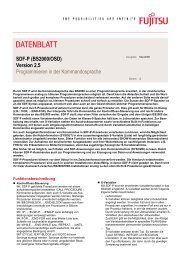Sizing Guide Exchange Server 2003 - Fujitsu
Sizing Guide Exchange Server 2003 - Fujitsu
Sizing Guide Exchange Server 2003 - Fujitsu
You also want an ePaper? Increase the reach of your titles
YUMPU automatically turns print PDFs into web optimized ePapers that Google loves.
White Paper <strong>Sizing</strong> <strong>Guide</strong> <strong>Exchange</strong> <strong>Server</strong> <strong>2003</strong> Version: 4.2, July 2006<br />
What’s new in <strong>Exchange</strong> <strong>Server</strong> <strong>2003</strong><br />
Microsoft <strong>Exchange</strong> <strong>Server</strong>‟s ten year history goes back to 1996.<br />
The first version of <strong>Exchange</strong> was version number 4.0 because it<br />
replaced the predecessor product, MS Mail 3.2. However,<br />
<strong>Exchange</strong> has as regards architecture nothing in common with MS<br />
Mail, except that both applications are basically used to exchange<br />
e-mails. Today, ten years after the market launch, <strong>Exchange</strong> bears<br />
the product name <strong>Exchange</strong> <strong>Server</strong> <strong>2003</strong> and the internal version<br />
number 6.5.<br />
After three years <strong>Exchange</strong> <strong>Server</strong> <strong>2003</strong> is the successor to <strong>Exchange</strong> 2000 <strong>Server</strong>. Based on the product<br />
name and the period of time that lies between the two product versions, it could be assumed that <strong>Exchange</strong><br />
<strong>Server</strong> <strong>2003</strong> has revolutionary changes to offer, but as can be seen from the internal version code, it is a socalled<br />
point release. In comparison with the changes between <strong>Exchange</strong> 5.5 and <strong>Exchange</strong> 2000 <strong>Server</strong>, the<br />
changes are less revolutionary and more of an evolutionary nature.<br />
Compared with its predecessor version <strong>Exchange</strong> 5.5, <strong>Exchange</strong> 2000 <strong>Server</strong> involved a completely new<br />
concept for database organization and user data administration, which had consequences up to and<br />
including the domain structure of the Windows network so that migration from <strong>Exchange</strong> 5.5 to <strong>Exchange</strong><br />
2000 <strong>Server</strong> was necessary. The consequence is that many <strong>Exchange</strong> users have shied away from these<br />
migration costs and are migrating directly from <strong>Exchange</strong> 5.5 to <strong>Exchange</strong> <strong>Server</strong> <strong>2003</strong>. On the other hand,<br />
the migration from <strong>Exchange</strong> 2000 <strong>Server</strong> to <strong>Exchange</strong> <strong>Server</strong> <strong>2003</strong> is proving to be considerably less<br />
problematic and is the equivalent of a simple update.<br />
Nevertheless, the new functions in <strong>Exchange</strong> <strong>Server</strong> <strong>2003</strong> as opposed to <strong>Exchange</strong> 2000 <strong>Server</strong> are not to<br />
be despised. And also with the Service Pack 1 (SP1) and Service Pack 2 (SP2) for <strong>Exchange</strong> <strong>Server</strong> <strong>2003</strong><br />
not only are problems fixed, they offer a lot of new and improved features, like mobile e-mail access with<br />
direct push technology and improved SPAM filtering methods with »Intelligent Message Filter« (IMF). The<br />
white paper entitled What's new in <strong>Exchange</strong> <strong>Server</strong> <strong>2003</strong> [L7] from Microsoft describes on more than 200<br />
pages the new features of <strong>Exchange</strong> <strong>Server</strong> <strong>2003</strong>, including SP2. The bulk of the new functions refer to<br />
security, manageability, mobility and client-side extensions, as provided by the new standard client for<br />
<strong>Exchange</strong> - Outlook <strong>2003</strong> and the revised OWA (Outlook Web Access). In the following we intend to<br />
concentrate on a number of outstanding innovations that have an impact on the hardware basis of an<br />
<strong>Exchange</strong> server.<br />
Shorter backup and restore times<br />
The Volume Shadow Copy Service (referred to in short as VSS) is in fact a new function of Windows<br />
<strong>Server</strong> <strong>2003</strong> and enables the creation of snapshot backups. <strong>Exchange</strong> <strong>Server</strong> <strong>2003</strong> is compatible with<br />
this new VSS function. Thus making it possible to take backups of the <strong>Exchange</strong> databases in a very<br />
short time and at the same time drastically reduce backup and restore times, which turn out to be the<br />
limiting factor in large <strong>Exchange</strong> servers. In the following chapters Consolidation and Backup this<br />
functionality is addressed in more detail.<br />
<strong>Exchange</strong> <strong>Server</strong> <strong>2003</strong> offers for the first time a simple method of restoring individual mailboxes. To this<br />
end, there is a separate Recovery Storage Group, which permits the restore of individual mailboxes or<br />
individual databases during operation.<br />
Extended clustering<br />
In contrast to <strong>Exchange</strong> 2000 <strong>Server</strong>, which<br />
supported a cluster with two nodes on the basis<br />
of Windows 2000 Advanced <strong>Server</strong> and four<br />
nodes under Windows 2000 DataCenter <strong>Server</strong>,<br />
<strong>Exchange</strong> <strong>Server</strong> <strong>2003</strong> permits a cluster with up<br />
to eight nodes to already be implemented on<br />
Windows <strong>Server</strong> <strong>2003</strong> Enterprise Edition.<br />
<strong>Exchange</strong> 4.0 v 4.0 Apr. 1996<br />
<strong>Exchange</strong> 5.0 v 5.0 Mar. 1997<br />
<strong>Exchange</strong> 5.5 v 5.5 Nov. 1997<br />
<strong>Exchange</strong> 2000 v 6.0 Oct. 2000<br />
<strong>Exchange</strong> <strong>2003</strong> v 6.5 Oct. <strong>2003</strong><br />
<strong>Exchange</strong> <strong>2003</strong> SP1 v 6.5 May 2004<br />
<strong>Exchange</strong> <strong>2003</strong> SP2 v 6.5 Oct. 2005<br />
Number of cluster nodes<br />
<strong>Exchange</strong> 2000<br />
Enterprise <strong>Server</strong><br />
<strong>Exchange</strong> <strong>2003</strong><br />
Enterprise Edition<br />
Windows 2000<br />
<strong>Server</strong> - -<br />
Advanced <strong>Server</strong> 2 2<br />
DataCenter <strong>Server</strong> 4 4<br />
Windows <strong>2003</strong><br />
Standard Edition - -<br />
Enterprise Edition - 8<br />
Datacenter Edition - 8<br />
© <strong>Fujitsu</strong> Technology Solutions, 2009 Page 4 (69)


